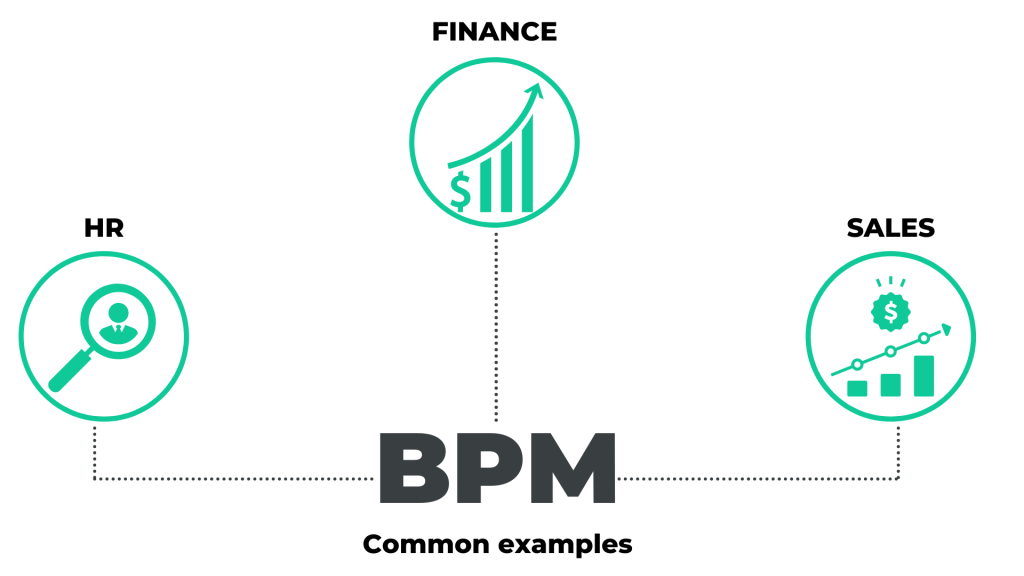- Adam Liberadzki
- Read in 7 min.
Like any tool – time rightness is substantial. Business Process Management Suite may be a very helpful solution for improvement in certain areas of business. Additionally, it is good to start with something simple enough to see results quickly, but also functional enough to really see and assess the outcome. Where do other companies usually apply BPM? In this article we share the reasoning behind making a decision to use BPM, alongside with some of the most popular examples of implementing BPM engines. It may inspire a business process automation journey in your organization!
Usually there are two main factors that may inspire using some kind of process automation tool in a company. It may either be a business-driven desire to measure, analyze and optimize processes, or an architectural need to level-up operational efficiency, increase visibility of processes, and enhance efficiency in delivering new functionalities.
Let’s check what could be the common motivations in both scenarios that could drive the decision to build some BPM solution.
Processes going fully remote
We are experiencing difficult pandemic times, when teams become more and more divided and work fully remote.
Operational inefficiencies
Some say that you cannot fix it if you cannot measure it.
The first sign it’s time for BPM is if you can find inefficiencies in your process in your business data. This is usually a matter of looking at KPIs specific to your business (production costs, production cycles, sales cycles, overall product/service quality) or of looking at the time it takes to move a project through a process, drilling into how long it takes at each stage.
For instance, say you are a sales driven organization. How long do leads wait in your system before a sales rep talks to them, or how long is your average sales cycle?
Most processes will have these sorts of metrics, and understanding where your time is going in a specific process is a good way to decide if there are any inefficiencies that you could improve.
Objectives are not being met
Businesses are always growing. No one ever says “I think I would like my business to shrink this year.” However, if then business process management might be able to help. Business process management can be brought in to help link organizational strategy, performance, and people to clear measurement and metrics. This helps you get a better picture of where you are, where you are going, and where you might be going wrong.
Market saturation
Dominating a single market is great… until that market is saturated and it starts to stifle growth. When this happens, there are really only two options to continue to grow the business:
- find a new market which is interested in your product or service;
- find a new product or service.
Both of these are time-consuming and can be very expensive propositions. In the meantime, business process improvements can help you find better margins in the markets you have already saturated by optimizing processes to get more work done faster and ultimately reduce the cost of delivering your product/service to customers.
Reaching new regions

Expanding a business into new territory is a significant undertaking. If you are a sales-driven organization, this will likely mean adding travelling or satellite salespeople outside your normal bounds of control and process.
If you are a services organization, it might mean opening a new office, where new systems and protocols will first emerge organically and later will have to be managed in line with existing structures. Finally, if you are a product company, it means you will have to establish new supply chains, logistics networks, stores, partnerships, and more to keep the stock flowing.
What these three things have in common is that authority and process become decentralized. It is challenging to manage a satellite sales office. Frankly, the head office isn’t there to have those conversations. The answer is robust processes that are fast, efficient, and make sense to the people who use them. Once you expand your organization, the culture of a head office isn’t enough to keep bad processes ticking along. They need to make sense to the people who use them if you want various ways of operating to be used.
Moreover, that means reviewing both formal and informal business processes to see what works, what doesn’t, and to get a better understanding of what’s going to weigh in (or not).
Easily modified software
From an architectural or technical point of view there are also many benefits that BPM can bring to the table. Typical, or perhaps better to call it “naive”, finite state machine implementation features a set of database tables tightly correlated to the data already managed and the process it flows through. There might be a way to keep past versions and track who took which action during the process as well. If it runs into problems, changes to data and process structure occur. Then those tightly coupled tables need to be altered to reflect the new structure and may not be backwardly compatible with the old ones.
A process (BPM) engine overcomes this challenge in two ways, by using serialization to represent the data and process, and abstracting integration points, in particular security. The serialization aspect means data and process can move together through the system. This allows data instances of the same type to follow completely different processes to the point where the process can be altered at runtime, by adding a new state for instance. And none of this requires changing the underlying storage.
Integration points are means of injecting algorithms into the process and ties to authentication stores (i.e. users who must take action). Injected algorithms might include determinations of whether or not a state is completed, whereas authentication stores example is LDAP.
Handling edge cases
The other aspect of a process engine is the experience embedded into its design and functionality that you will likely not consider rolling your own one and you may regret not having it when you need it. Two cases that often come to mind are timed tasks and parallel execution paths.
Timed tasks assign an agent responsible for data after a certain period passes. For instance, a press release is written and submitted for approval, and then remains on hold for about a week without any review. You probably want your system to identify that lingering document and draw the attention of the interested parties.
Parallel execution paths are not uncommon and occur pretty regularly. Their main concept is that a given piece of data is split and sent into two different paths of review or processing, only to be recombined later. This kind of issue demands having useful merging algorithms and the ability to simultaneously represent the data multiplication. Weaving that into a hand-made solution after the fact is much trickier than it may seem, especially if you want to keep the track of historical data.
Process-centric tools
BPM is suited for applications with an essential sense of state or process i.e., applications that are process-oriented. An application passes the BPM acid test if it is genuinely process-oriented. The travel agency application, for instance, passes this test because it is best comprehended in terms of state of the itinerary and is defined by how far the itinerary has gotten. Other typical features of a process-oriented application include the following:
- long-running – from start to finish, the process spans hours, days, weeks, months, or more;
- persisted state – because the process is continuous, its state is persisted to a database so that it outlasts the hosting server;
- bursty, sleeps most of the time – the process spends most of its time in stand-by mode, waiting for the next event to occur, at which point it wakes up and deals with a pile of activities;
- orchestration of system or human communications – the process is responsible for managing and coordinating the communications of various systems or human agents.
For example, in an automated teller machine, which lets users query their account balance, withdraw cash, deposit checks and cash, and pay bills – any sense of process is fleeting and inessential. An ATM is an online transaction processor, not a process-oriented application.

HR
Have you ever felt your organization’s onboarding process is too complex and chaotic? Does your HR department ask the candidates to fill out extensive paper forms? This is because your HR department lacks the principle of BPM. Applying business process management, helps you automate your HR processes end-to-end. Including cutting down on cost, time, and paper. Here are a couple of examples as to how BPM helps your HR department improve its procedures:
- approve employee timesheets faster;
- onboard new hires without bother.
Sales
In most organizations, the sales team spends a significant amount of time coordinating the Accounts Receivable (AR) team, to get sales invoices approved. Even a small typo in invoices, can ruin lives of the salespeople. This is where business process management steps up, since it automates the invoice approval process, and by the same token eliminates the chances of manual errors and back and forth clarifications between the salespeople and the AR team. Here are a couple of scenarios in the sales department, where business process management can help streamline the processes:
- shorten your sales cycle workflows;
- on-time quotes and invoices.
Finance
A finance team is always bombarded with paper forms and emails every day since anything that includes money has to go through them. E.g.: if the asset management team wants to purchase 50 laptops, they send the quotation that they received from the vendor to the team responsible for finances for their approval. That’s just one case. Imagine how many emails and paper forms they receive daily. Without a system working properly, it is a true nightmare for them to manage all of these. BPM system helps them manage all of this. Here are a couple of scenarios in the financial department, where business process management comes as a saving grace:
- one-click approvals for travel requests;
- customized workflows for unique scenarios;
- features every competent business process management tool should have.
Summary
Business process management is one of those activities that always seems to be pushed to the bottom of the priority list as more due matters crop up for resource allocation. However, there are some situations where it just can’t be pushed away anymore.
Once all of inefficiencies in your processes are discovered, which not surprisingly halt meeting business objectives. A complete saturation of the market, or undertaking major business expansions are priorities that should trigger a profound BPM review.
If your system is unlikely to change, rolling regular custom applications may be an easier solution, particularly if alterations can break old data. But if you suspect you have a need for that type of agility and observability, a BPM tool provides a lot more flexibility and security that you won’t paint yourself into a corner as the data and business processes change.
Check out our smart process automation services
Let us help you unlock your business operations efficiency







